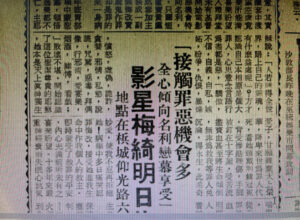現代トルコにおける福祉とイスラーム――震災時の慈善団体の活動から――
対象とする問題の概要 2023年2月6日現地時刻午前4時16分、マグニチュード7.8の地震がトルコ南東部のシリア国境付近で大規模な地震が発生した。約9時間後、最初の地震の発生地から北西に95km離れたところを中心に発生した。地震が起きたと…

News article covering the revival meetings in 1963 September from SING PIN JIH PAO
Charismatic Christianity was historically estranged by traditional denominations due to its association with heresy and extremism. However, it gained acceptance in the mid-20th century, leading to the Charismatic Movement, with mainline churches adopting charismatic beliefs. This was succeeded by the Neo-Charismatic Movement, marked by independent churches emphasizing the Holy Spirit’s role. These movements have significantly impacted the landscape of world Christianity.
Charismatic Christians have risen to 601 million in 2008, and is expected to reach 798 million by 2025. Charismatic Christians now constitute around 2/3 of all Protestants globally[1]. Malaysia felt the influence of these movements as well, with Charismatic Christians rising from 25% of the evangelical Christian population in the 1950s to 75% by 1985[2].
Charismatic or Neo-charismatic, have reignited interest in miracles, supernatural gifts, and exorcism, aspects Weber would categorize as “magic”. They represent a global Christian religious movement that has attracted numerous converts to Christianity. Despite being peripheralized by mainstream Christian denominations for much of the modern history, it never disappeared and could in fact be traced back to the Holiness Movement in 19th century America.
The historical resilience of Charismatic Christianity is a subject deserving of scholarly inquiry, but understanding the reason of its remarkable growth is a separate matter. Many scholars had attempted to answer the latter question from different perspectives. Ackerman and Meyer, among others, have examined how it helps individuals maintain a modern or minority identity during cultural crises. My research builds on this, comparing successful and less significant revival movements in Malaysian history to understand how Charismatic Christianity reshapes identity and prospects. The focus is on the impact of political imbalances on cultural identity and factors influencing religious conversions within the post-independence Malaysian Chinese community.

Lantern riddles traditionally used for guessing the answer from chinese poem or a phrase, now use to manifest bible stories and morals
While visiting the four Charismatic churches in various Malaysian cities, two questions have been on my mind. (a) What encourages the converts to choose Charismatic Christianity? (b) What significance does the new religion have for these converts? With these questions in mind, below are my findings:
(1) Archival Data
During my visit to the Centre for Malaysia Chinese Studies, I came across news articles from 1963 that detailed the events of the revival meetings I am researching. These articles shed light on the community’s reactions to the missionaries and Charismatic Christianity as a whole. By reviewing these news archives which reflected the comments and emotions of the community, I am able to identify the factors hindering the development of Charismatic Christianity in the 1960s.
(2) How do these converts perceive their own cultures?
Through interviews with converts, I gained insights into the significance of their religious conversions and how they perceive their past post-conversion. These converts all regard their choice to embrace Charismatic Christianity as rational and wise. While they acknowledge the importance of their former faith, they view any association with idolatry[3] as superstitious and linked to malevolent spirits. Upon conversion, their perspective on cultural festivals, such as the Mid-Autumn festival, shifted. Traditionally in Chinese culture, this festival honors ancestors and is appreciated as a day to reunion with family, but after adopting Charismatic Christianity, the festival became centered around church activities. This transformation distinctly set them apart from the broader Chinese community.
Besides examining national news archives, I shall locate smaller, region-specific news publications offering detailed coverage of the revival meetings. Additionally, further effort is required to investigate the national policies that contributed to the cultural crisis in the 1960s and 70s.
[1] Anderson, A. (2013). Introduction. In An Introduction to Pentecostalism: Global Charismatic Christianity (Introduction to Religion, pp. 1-16). Cambridge:Cambridge University Press.
[2] Huat, T. J., & Robeck, C. M. (2011). Pentecostals and Charismatics in Malaysia and Singapore. In A. Anderson & E. Tang (Eds.), Asian and Pentecostal: The Charismatic Face of Christianity in Asia Revised Edition (2nd ed., pp. 227–247).1517 Media.
[3] In this context, ‘idolatry’ refers to their previous religious beliefs, which often included Hinduism, Taoism, and Chinese folk religions. This term is used to align with their own preferred terminology.
Copyright © 附属次世代型アジア・アフリカ教育研究センター All Rights Reserved.